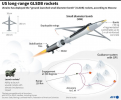Antares
Respected Leader
Tämän mukaan Ukraina voisi saada ensimmäisen erän GLSDB-pommeja kenties jo huomenna (artikkeli julkaistu 30.1.2024):
The US has successfully tested a new, long-range Ground-Launched Small Diameter Bomb for Ukraine that is expected to arrive on the battlefield as soon as Wednesday, according to a US official and three other people with knowledge of the talks.

Airman 1st Class Jonathan Catalano handles a rack of inert small diameter bombs during readiness training at Joint Base Elmendorf-Richardson, Alaska, Feb. 9, 2018. | U.S. Air Force photo by Alejandro Peña
By LEE HUDSON, LARA SELIGMAN and PAUL MCLEARY
01/30/2024 01:11 PM EST
The Pentagon has successfully tested a new long-range precision bomb for Ukraine that is expected to arrive on the battlefield as soon as Wednesday, according to a U.S. official and three other people with knowledge of the talks.
Ukraine will receive its first batch of Ground-Launched Small Diameter Bombs, a brand new long-range weapon made by Boeing that even the U.S. doesn’t have in its inventory, according to the four people, all of whom were granted anonymity to discuss matters ahead of an announcement.
The new bomb, which can travel about 90 miles, is expected to be “a significant capability for Ukraine,” said the U.S. official.
“It gives them a deeper strike capability they haven’t had, it complements their long-range fire arsenal,” the U.S. official said. “It’s just an extra arrow in the quiver that’s gonna allow them to do more.”
An Army spokesperson did not immediately respond to a request for comment.
The weapon, co-developed by Boeing and Saab, is made up of a precision-guided 250-pound bomb strapped to a rocket motor and fired from various ground launchers. The U.S. military has a similar version of the bomb that is air-launched, but a ground-launched version does not yet exist in U.S. inventory.
The Pentagon announced last February that the Biden administration was providing the new bomb to Ukraine. But before sending the new version, the U.S. military needed to test the weapon — and that took many months.
The Army oversaw the testing of the new precision-guided bomb before providing its stamp of approval to send the weapon to Ukraine, according to an industry source.
The air-launched version was created in 2019, but despite successful tests, Boeing and Saab did not make a sale until the U.S. decided to donate it to Ukraine as part of an aid package.
The Biden administration has already provided Ukraine with a limited number of longer-range weapons. Last fall, officials secretly sent a version of the Army Tactical Missile System, which carries warheads containing hundreds of cluster bomblets that can hit targets 100 miles away.
-
Artikkelin mukaan kantomatka olisi 90 mailia eli noin 145 km.
Taistelukärki on 250 pounds eli noin 113,4 kg. MUOKKAUS: tosin alla olevan kuvan mukaan se olisi 93 kg, tiedäpä näistä.
Määristä ei tietysti puhuta mitään.
-
Lisää aiheesta:
Some unexpectedly good news. The DoD has taken delivery and completed test shots of the first serial production lot of the Boeing-Saab Ground-Launch Small Diameter Bomb. The first lot is expected to be delivered to Ukraine in the next 24-48 hours.

The US has successfully tested a new, long-range Ground-Launched Small Diameter Bomb for Ukraine that is expected to arrive on the battlefield as soon as Wednesday, according to a US official and three other people with knowledge of the talks.
New US-made longer-range bomb expected to arrive as soon Wednesday in Ukraine
The Ground-Launched Small Diameter Bomb doesn’t even exist in the U.S. inventory.
Airman 1st Class Jonathan Catalano handles a rack of inert small diameter bombs during readiness training at Joint Base Elmendorf-Richardson, Alaska, Feb. 9, 2018. | U.S. Air Force photo by Alejandro Peña
By LEE HUDSON, LARA SELIGMAN and PAUL MCLEARY
01/30/2024 01:11 PM EST
The Pentagon has successfully tested a new long-range precision bomb for Ukraine that is expected to arrive on the battlefield as soon as Wednesday, according to a U.S. official and three other people with knowledge of the talks.
Ukraine will receive its first batch of Ground-Launched Small Diameter Bombs, a brand new long-range weapon made by Boeing that even the U.S. doesn’t have in its inventory, according to the four people, all of whom were granted anonymity to discuss matters ahead of an announcement.
The new bomb, which can travel about 90 miles, is expected to be “a significant capability for Ukraine,” said the U.S. official.
“It gives them a deeper strike capability they haven’t had, it complements their long-range fire arsenal,” the U.S. official said. “It’s just an extra arrow in the quiver that’s gonna allow them to do more.”
An Army spokesperson did not immediately respond to a request for comment.
The weapon, co-developed by Boeing and Saab, is made up of a precision-guided 250-pound bomb strapped to a rocket motor and fired from various ground launchers. The U.S. military has a similar version of the bomb that is air-launched, but a ground-launched version does not yet exist in U.S. inventory.
The Pentagon announced last February that the Biden administration was providing the new bomb to Ukraine. But before sending the new version, the U.S. military needed to test the weapon — and that took many months.
The Army oversaw the testing of the new precision-guided bomb before providing its stamp of approval to send the weapon to Ukraine, according to an industry source.
The air-launched version was created in 2019, but despite successful tests, Boeing and Saab did not make a sale until the U.S. decided to donate it to Ukraine as part of an aid package.
The Biden administration has already provided Ukraine with a limited number of longer-range weapons. Last fall, officials secretly sent a version of the Army Tactical Missile System, which carries warheads containing hundreds of cluster bomblets that can hit targets 100 miles away.
-
Artikkelin mukaan kantomatka olisi 90 mailia eli noin 145 km.
Taistelukärki on 250 pounds eli noin 113,4 kg. MUOKKAUS: tosin alla olevan kuvan mukaan se olisi 93 kg, tiedäpä näistä.
Määristä ei tietysti puhuta mitään.
-
Lisää aiheesta:
Some unexpectedly good news. The DoD has taken delivery and completed test shots of the first serial production lot of the Boeing-Saab Ground-Launch Small Diameter Bomb. The first lot is expected to be delivered to Ukraine in the next 24-48 hours.

Viimeksi muokattu:






